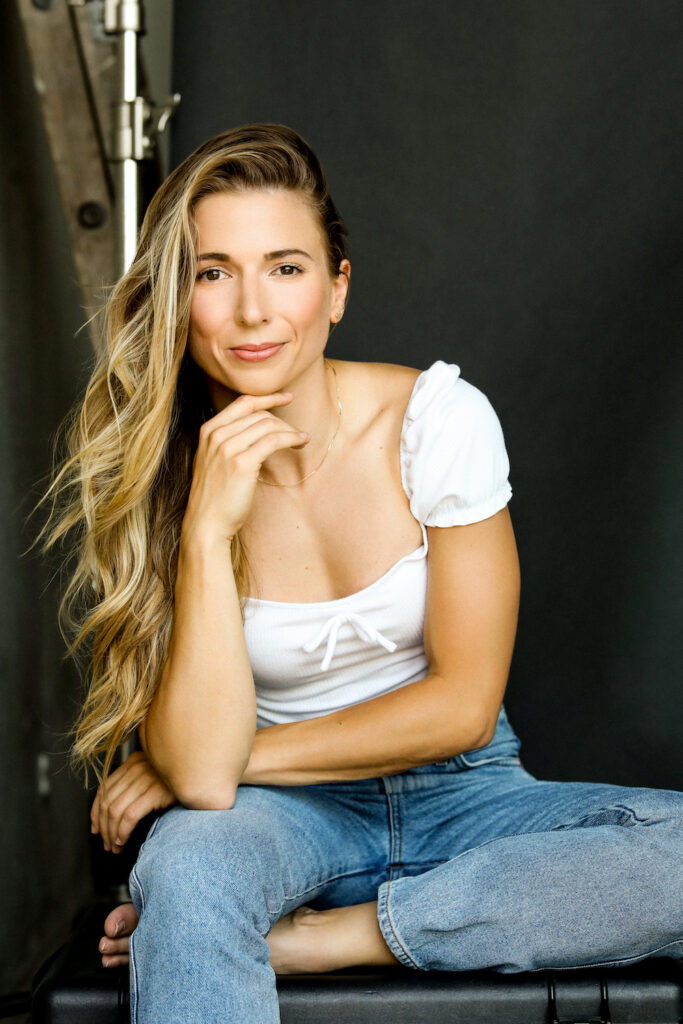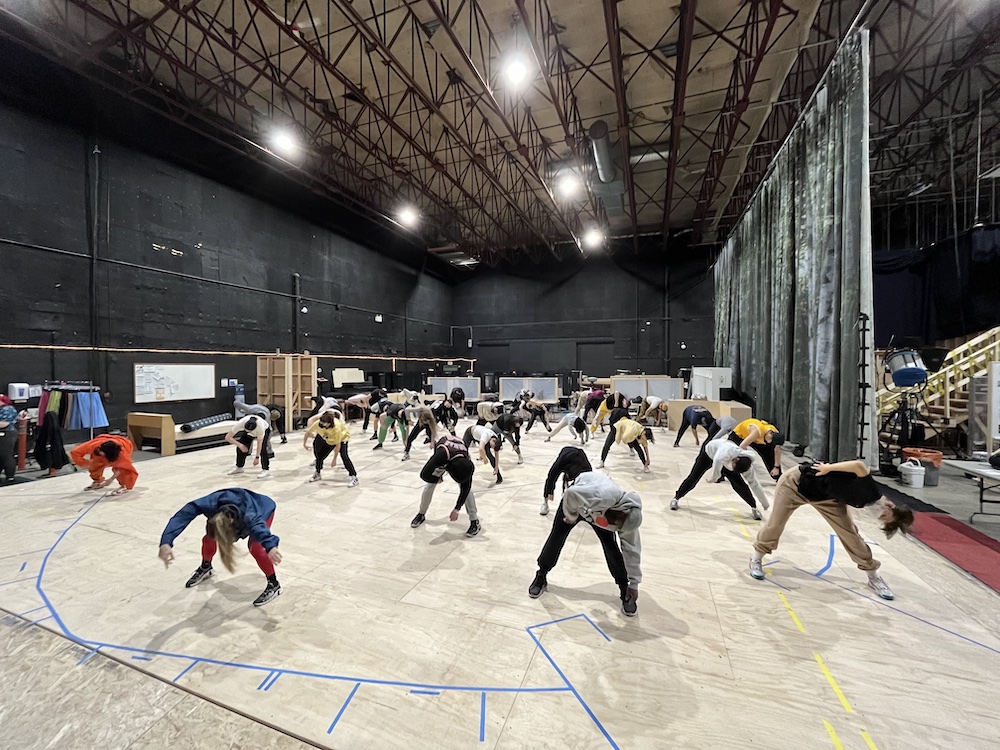With the recent SAG-AFTRA strike, we checked in with our neighbors north of the border, who are voting on a strike of their own. What do unions look like in Canada? Well, Canadian dancers now have a stronger voice in the British Columbia region, thanks to a recently formed Dance Committee under the established Film and TV union there, UBCP-ACTRA.
We sat down with Louise Hradsky in Vancouver, Canada, who is co-chair of the Dance Committee. Hradsky is a choreographer, dancer and advocate for dancers in the BC film industry – where many American shows get filmed.
Hradsky is accomplished, having choreographed for productions like To All The Boys: Always and Forever and Charmed. Her committee co-chairs Jeffrey Mortensen and Melena Rounis are equally accomplished, with credits on shows like Zoey’s Extraordinary Playlist and Peacemaker, respectively. Most recently, Hradsky and Mortensen won a LEO award and have been nominated for an Emmy for their work as choreographers on Grease: Rise of the Pink Ladies. This is clearly an experienced group, but when did they finally feel established enough to take on this leadership role?
“For me, it was around my 15-year mark of being in film and TV,” says Hradsky. “Since my first job, I had been hearing dancers voice issues, but only amongst themselves, always maintaining this culture of ‘keep your head down, work hard, and don’t complain.’ I strongly believe it’s possible for dancers to maintain the great work ethic we’re known for, while professionally communicating certain basics required to do a quality job. Whether it’s appropriate rates or rehearsal time, discussing what’s needed to deliver high caliber work is important. After 15 years, I realized I was in a place as a leader in the community to foster something.”
In late 2020, the UBCP film union contacted their choreographer and dance members about forming a focus group, before heading into negotiations with producers for the British Columbia Master Production Agreement. The BCMPA establishes protocols and minimum rates for cast and some crew in BC Film and Television. These negotiations only happen once every three years.
“Some key members showed up enthusiastic and prepared for the focus group,” explains Hradsky. “We were articulate and concise with our discussion points. It became clear to UBCP, and to us, that we could really benefit from working together. Formation of our committee snowballed from there; we started chatting with different dancers and choreographers in our community, and had informal meetings on Zoom. We had incredible guidance from UBCP, and modeled the structure of our committee off of the existing UBCP Stunt Committee.”
The Stunt Committee is a force – when safety is on the line, voices need to be heard and respected. Stunts carry the risk of high impact accidents – but much like dance, it also affects your body over time, resulting in ‘wear and tear’ injuries. While dancers might not seek the same hazard pay stunt performers require, a bump in pay to account for the necessary physiotherapy, chiropractic and other body maintenance seems like a reasonable ask.
Hradsky, an active member of the stunt community herself, was inspired by how much ground they’ve covered by coming together. “Other than risk, the job we do is very similar. You have to be able to learn choreography, perform for camera and figure out all the physical logistics. When I saw that parallel, and how cohesive the stunt community is, it inspired me.”
While Hradsky includes pay increases in her goals for industry reform, she makes clear that pay isn’t the only inequity that needs attending.
“Sometimes, there’s a feeling of disconnect with other departments on what dancers and choreographers bring to the table. I had run into dismissive attitudes towards our contribution many times, but all that changes once they see what we bring to a scene,” Hradsky notes. The Dance Committee seeks to solve that with education and representation, but also by shifting the culture inside the dance community itself.
“Professionalism on set is critical. In many cases, there’s an inherent youthfulness to dance which can be perceived as play instead of work,” Hradsky says. “We’ve trained our whole lives to do this, though, and we have a responsibility to conduct ourselves in a way that represents that to other departments, producers and directors.” Historically, infantizing dancers is a common issue, and with that comes silencing or disregarding their voices. But on a film set where there are so many moving parts, if you don’t learn to speak up, you won’t get what you need.
And choreographers are the designated spokesmen. “What we have to understand is the choreographer is the supervisor, the head of department for all the dancers. That means you’re responsible for their safety and wellbeing,” Hradsky says. “It’s something no one teaches you, but is critical to get a sense for.” Dancers need to feel safe voicing concerns to their choreographer, and choreographers need to feel comfortable addressing them with production so that they can be resolved.
Hradsky has built a reputation for taking care of her performers, advocating for what they need while working with production to make it happen. From figuring out the logistics of pointe shoes with the costume department, to ensuring her dancers aren’t asked to repeat demanding choreography without adequate breaks. The committee accomplishes this on a larger scale.
She notes that only pushing for change every three years when the BCMPA gets renegotiated isn’t an effective path forward. “What is effective is if we come together and decide what we want to work towards. Even if it never makes it into the written agreement, if all the choreographers agree that this should be standard, and all of the dancers understand that their choreographers should be providing that for them, then we are moving in a positive direction.”
Then by the time that three year re-negotiation rolls around, there’s precedent established in the community already. “It’s important we’re all on a similar page about what it takes to deliver a job,” Hradsky says. “Contracts can vary depending on experience level and production budget, but if we can pin certain things as standard, we’ll gain power through consistency, regardless if they’re in the written agreement or not.”
These goals are similar to the ones the American WGA and SAG strikes are working toward. Hradsky recognizes, “I have some incredible friends and colleagues in the U.S. who are helping make huge moves. They’ve just formed the Choreographers Guild, so for the first time film and TV choreographers have the consistent opportunity to be unionized, which has been a big difference between working in the United States and Canada.”
The Canadian film and TV market is competitive in the global scene, and is taking steps for their dancers to maintain competitive compensation. “As Canadians, it’s easy to have stars in our eyes for other big cities in the world in terms of the caliber of dance and professionalism,” Hradsky says. “However, cities like Vancouver and Toronto have so much work flowing through them, so many artists gaining extensive flight time and experience. We have an incredible community of professionals, and the work we’re delivering on camera is second to none. The other layer to this is, what can we do to advance the perspective of what choreographers and dancers bring to projects.”
And that’s a global moral for dancers everywhere. We have to recognize our own value in order for others to see it, too. Organize within your community and advocate together – committees are formed from communities.
By Holly LaRoche of Dance Informa.


















